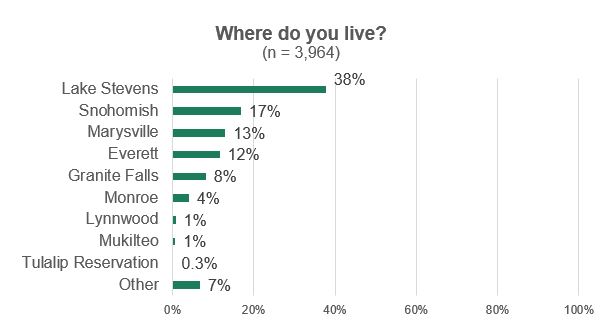By: Jennifer Rash
Last summer, we launched a study about the US 2 trestle. We’ve studied this trestle in the past, but this study is different because we’re looking at connections from the trestle to other highways, like I-5. The study will also consider how to improve bike, transit and freight trips around and across the trestle.
 |
| Expanded study area that includes the US 2 trestle and other connecting highways, including I-5. |
This kind of study is called a PEL—that stands for Planning and Environmental Linkages. One of the most important benefits of this type of study is early input from agencies, tribes, and community members so we can get thoughts on issues and priorities before we develop plans. In fact, we recently collected input from the public and others just to write the study Purpose and Need statement.
What is a Purpose and Need statement?
This statement does two things. First, it explains why we are studying improvements at this specific location. That’s the “purpose” part. Second, it explains the issues that need to be fixed. That’s the “need” part. A bonus benefit is that this Purpose and Need statement can be re-used for the environmental review. That review starts right after the PEL is complete, and having the Purpose and Need statement pre-approved by the Federal Highway Administration (FHWA) can speed things up.
Public input informed the final Purpose and Need statements
This spring, we hosted an online open house and survey to gather feedback on the draft Purpose and Need statements. Through survey responses and comments, we learned more about how the community travels on or near the trestle.
Over 10,000 people visited the online open house website, and the survey received nearly 4,000 responses. The following graphs and statistics represent a small sample of the data collected. The full online open house and survey summary is available in the study document library.
Most people (around 70%) in the survey said they live on the east side of the trestle.
Most people said they use the trestle to access essential services like grocery shopping and medical visits. Commuting to work was the fourth most popular type of trip.
We wanted to learn about the biggest challenges to traveling on or around the trestle. Traffic back-ups and unreliable travel times were the biggest issues. Lack of detour options and safety were also common answers.
We then asked folks to review the draft Purpose and Need statements. Over 70% of people supported the statements as written. Some people gave us feedback that led to edits. For example, some people were confused about how we used the word equity. People also wanted to include more eastbound trestle concerns. We revised these statements before sending them to FHWA for approval, acknowledging that public input influenced these revisions.
You can view the draft and final Purpose and Need statements in the study document library.
Feelings about tolling
One of our big takeaways was community opposition to tolling, with 75% of survey takers against it. Many were concerned that tolling could negatively affect the cost of living in communities on the east side of the trestle. Around 15% of survey takers supported tolling the trestle, with some saying it could encourage transit use and others that users should pay for improvements to the trestle—as long as the toll is reasonable.
We will consider tolling as a way to address study needs, though we don’t know yet what types of tolling or the potential toll rates we’ll study.
In general, WSDOT is involved in planning, construction, and operations of tolling projects. The Washington State Legislature authorizes toll facilities and determines how to spend toll revenue. The Washington State Transportation Commission sets toll rates and exemptions with an extensive public input process.
What’s next?
We will work with FHWA and our PEL Study advisory groups to develop a list of possible improvements. We’ll start with a lot of ideas and whittle them down to a few concepts to study in the environmental review. The concepts are first evaluated at Level 1. If they meet the Purpose and Need criteria, as well as more detailed criteria, then they are evaluated in Level 2. We plan to share concepts between Level 1 and Level 2 for public comment in early 2025.
To follow along with the study, consider signing up for the WSDOT Snohomish County Newsletter email updates. We also regularly update our study web page and document library. Thank you again to everyone who participated in our online open house and shared their thoughts with us!




No comments:
WSDOT comment policy
Post a Comment